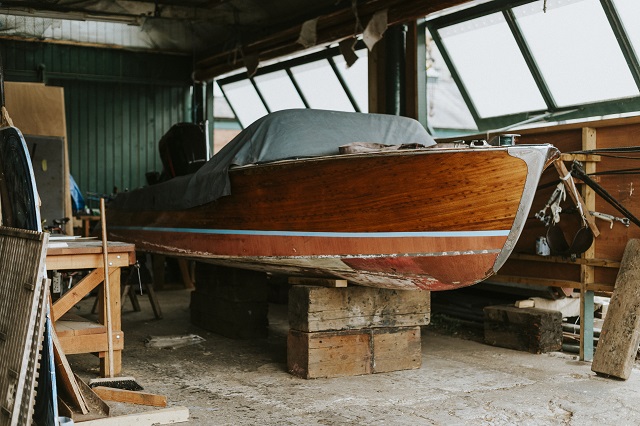So, you want to build a boat? In your backyard? By hand? Truthfully, constructing a vessel that will hold a human (or several) without taking it on water is tricky. It requires ample space, skill and patience, not to mention time and money.
Most boat-building ventures take at least six months, working in the evenings and on the weekends, and cost at least a few thousand dollars. Of course, your exact commitment will vary greatly depending on the size and type of boat you want to build and the materials you choose. Naturally, a kayak or canoe will take a lot fewer resources than a powered yacht.
The one thing every hobby shipwright will need, however, is a miniature shipyard — a space where you can house and work on your boat.
So, before you print the plans, buy the supplies and start building, take the time to set up your work area with your end goal in mind.
Here are a few tips to do just that.
Choosing the Space
If you have an existing garage, barn or basement consider yourself lucky. These spaces typically already check most of the boxes when it comes to a functional location for boat building.
If you aren’t so fortunate, don’t worry. You can always build a temporary shelter or build offsite in a rented or borrowed space. No matter where you end up, you’ll need the following features:
- Space – Ensure the location you choose is big enough to fit your completed boat, if you plan on assembling the whole thing indoors, as well as all your tools and equipment.
- Access – Maneuvering a finished boat out of a space is no easy task. Make sure the space has a big enough door.
- Humidity – Too much moisture makes wood expand, while too little can cause it to contract. Neither of these extremes are ideal, so look for a place that is climate controlled. Otherwise, you may have to hire a pro to install a humidifier with a humidistat to keep the humidity consistent.
- Ventilation – When you’re working with wood, you will inevitably generate saw dust. Too much of the dust can cause respiratory issues. You may also be using glue or applying varnish, which may be harmful to inhale. In addition to the proper personal protective equipment, you need to be sure your work space has proper ventilation. You may need the help of a dust-collection system, downdraft table, or exhaust fan. Fresh air is also important to maintain your boat as you build. The hull will need to be up off the ground or floor to start. You may need to invest in a fan to circulate air as well.
- Power – Unless you plan to saw and sand everything by hand, you’ll need electrical access. If you plan to run an extension cord from another power source or are using more equipment than usual, check with a licensed electrician to be sure your electrical panel can handle the added strain.
- Water – You’re going to want to test your boat at various stages of the building process, so it would be convenient if your shipyard was near water of some kind. For small boats, a swimming pool may work. For larger watercrafts, the nearer you are to a boat dock or ramp, the better.
Equipping the Space
Once you’ve secured a workspace, it’s time to equip it. In addition to basic tools and supplies, like sawhorses, clamps and hand tools; you may need some specialty items that cost more, take up added space or require special skills to use. The investment will be worth the time and money it will save you by allowing you to use your resources more efficiently.
- Workbench – There will most definitely be times that you will need a desktop to review and update your plans, complete a detailed task or even have a quick meal. Other than a large, smooth worksurface, you just need a task light to keep the surface lit and reduce eye strain.
- Miniature crane or lift – A modular lift can help you maneuver your big, awkward creation into position as you work. It can also help you move heavy equipment around your work area.
- Table saw – While you can saw all your wood by hand or have a local hardware store cut it to size for you, having a table saw in your workshop will give you much more flexibility and save you a boatload of time.
- Planer – A planer will allow you to adjust the thickness of the boards you’re using on the fly, which is imperative when bending wooden planks to shape a hull. Having this tool on hand may also allow you to use wood you wouldn’t have been able to before, saving you resources.
- Router – Slotting wood to fit together, cutting panels flush, flattening warped boards, rounding edges, and cutting joints, mortises and tenons will be easier with a router and a set of bits.
In short, building a boat in your backyard is as difficult as it sounds, but the sense of accomplishment you get will be well worth the effort. (Plus, you get a boat.) Just ask someone who’s done it!

 Dining Room Sets
Dining Room Sets  Architectural Salvage
Architectural Salvage  Enhance Home Design with Decorative Leaded Glass
Enhance Home Design with Decorative Leaded Glass  Condo Renovation Considerations to Save Space
Condo Renovation Considerations to Save Space  How to Create a Peaceful At-Home Hospice for Your Loved One
How to Create a Peaceful At-Home Hospice for Your Loved One 

Are You Familiar With This Topic? Share Your Experience.